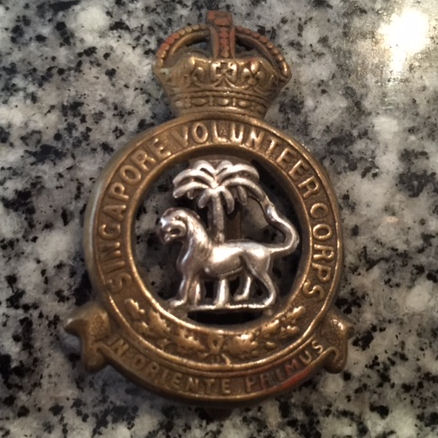-
Posts
4,862 -
Joined
-
Last visited
-
Days Won
15
Content Type
Profiles
Forums
Blogs
Gallery
Events
Store
Everything posted by peter monahan
-

Please help to ID this
peter monahan replied to DrT's topic in Great Britain: Militaria: Badges, Uniforms & Equipment
Perhaps an unissued example, liberated from stores, would explain the lack of identifying numeral as well - hasn't been applied yet. That hadn't occurred to me but makes a certain amount of sense. Good thought, Michael! -
Well, if the repros are themselves 100 years old, that gives them an interest and value that the c**p being put together in 'the East' and sold as real doesn't have. In the case of my friend, however, part of his task is/was to convince the owner of the uniform that it was not un fact 200 years old, as I believe it was purchased as such. That said, yes, well made repros. have a place in collections. I'll certainly never spend the money, for example, to a genuine light company officer's sabre to go with the British uniform I wear at re-enactments and, when I hang up my spurs I assume that one of my kid's will keep the sword as a souvenir of my starnge hobby, so it too will be 'collectible' in the broad sense. I also hope, given what I paid for it, that my tunic doesn't wind up in a rag bag or at the local Good Will store.
-

Unkown Uniform
peter monahan replied to Hermann's topic in Great Britain: Orders, Gallantry, Campaign Medals
I can see that, but the bars were quite common on early Victorian medals, as it wasn't yet the custom to sew them to the uniform. -
My only contribution to the theread is to agree that 19th century repros. are common. A friend, a professional uniform maker was, last time I saw him, refurbishing an officer's dress uniform which the owner believed original but which my friend thinks is a good quality repro., based on the fact that bits of it are machine sewn. That, of course means that at the very least it has been re-worked and, given the lasting popularity of l'Empereur it would be amazing if people hadn't done copies of his troops' dress over the last 200 years!
-

Unkown Uniform
peter monahan replied to Hermann's topic in Great Britain: Orders, Gallantry, Campaign Medals
I agree with Mike about the medals, though no idea on the middle one, and the uniform may very well be diplomatic or perhaps a county Lieutenant Governor's. -
Odd, I didn't get the impression that anyone in Antwerp was feeling oppressed, though the propriater of a book shop [Flemish] got quite shirty with me when I enquired - In French, I'm afraid - if she had any books in English or French. I was looking for a bird guide and didn't think one in Flemish would help me much!
-
I can't say I like the 'combined' order nearly as well as the pieces posted earlier, but that is just me. Interesting, as you say, that the Portugese influence is still strong post independence.
-
The size is certainly appropriate for a helmet plate but the construction is not. They were typically stamped out, so the reverse of the badge showed the design too, whereas this looks cast and, I suspect, very heavy for something worn on the head. The Wikipedia article on the Singapore volunteers shows what it identifies as a 'crest' for the unit and I suspect this is similar: meant to go on a plaque or wall rather than on a soldier's kit. Possibly even an auto badge. Below is an example of a cap badge, 'borrowed' from the British badge Forum and you can see the difference in construction. You might also consider consulting the author of a blof on the SVC, found here: http://sgvolunteerscorps.blogspot.co.uk
-

Help Identifying Medal Records
peter monahan replied to Dazza_22's topic in Great Britain: Orders, Gallantry, Campaign Medals
The other possibility - I can't get a good enough look at the entry on my computer to read it clearly - is that the reference is to the authorizing order, in which case the numbers may be either the date the clasps were authorized for issue, the date all clasps to WWII stars were authorized or not even a date at all but a reference number. Just a thought. -
The document is a Dutch Marriage Certificate from the Municipality of Berchem, part of southern Antwerp, for the marriage of Edwards Nicholas Deeds and a Bertha Wauters, presumably a Dutch girl, so Driver Needs brought home a war bride after his soldiering in Africa, Italy and the Netherlands. Well done, that man! Sadly, WWII British medals were not named. Nor were those issued to Canadians or Aussies, I think, but South Africa and the Indian Army went the extra furlong and had them named.
-
Norstrom - I just noticed the two 'dagger' threads now. When I was more involved in buying and selling militaria, back in the 1970s and '80s, these daggers were already being copied. That means that the fakers have had 40 ears to get the copies right, so unless you have a lot of really trustworthy and expert advice, I'd stay away from these entirely. All to easy to get your fingers and pocketbokk badly burned! Peter
-
The trouble with brass is that you ave to polish it! I've just reclaimed a 'seaman's chest' - a large mahogany chest with two drawers, meant for storing clothes. Not really for a seaman, of course, because it's too large and there is no provision for keeping the drawers from sliding open in rough weather, but the style is very nautical. The 'down side' are the two large brass bands around it, which would I'm sure look fabulous for a week or two after I polished them, beofre returning to their present dull and discolored state. If I had a maid, of course, that would be a different story, but every time I suggest that my wife put on the lovely little 'French maid' outfit I bought her, she hits me!
-
Lovely photos, Karhu. These are very attractive looking orders too which, sadly, is not always the case with the ODM of the newer nations, where national and political symbolism often seems to over rule heraldic and aesthetic factors. Thank you for sharing them. The Diploma attached also gives a good idea of the sort of thing for which the Distiguished Service medal is awarde so, again, thank you for sharing that.
-

Uncategorised Finds of the day
peter monahan replied to Stuka f's topic in Non Military Collectibles & Antiques
-
Wonderful info. from both posters! Thank you. Karhu, you actually have photographs of one of the awards being worn. May we ask how you were lucky enough to get that? Is it your own? :)
-

Mervyn Mitton
peter monahan replied to Craig's topic in Great Britain: Mervyn Mitton's British & Colonial Police Forces
As I got more deeply involved with this group and, at Mervyn's suggestion I might add, became a moderator, he was always ready and indeed eager to give advice, make comments and generally keep me from making to many new boy errors. On a personal note, when he discovered my daughter was heade to SA he offered to connect us with friends of his in Capetown, though he had never met either of us. An expert in many areas but, much more importantly, a true 'gent' in the old school sense. He will be missed. -
Paul, you are correct about the Indian units too. High caste Hindus did not cross the Kala Pani [black water] if they could avoid it and had to pay a priest for an expensive ritual cleansing afterwards if they did. In fact the Indian Mutiny, now referred to by some as 'The First Indian War of Independence', was at least partly an industrial dispute, with strong cultural overtones! The HEIC had cancelled the field allowance - 'batta' - for service in Burma, as it was no longer considered 'foreign service' but Brahmins, who already saw their caste priviliges under attack, still had to pay to be purified. That, some prosletyizing by English missionaries and the better known 'cow fat/pork fat on cartridges' rumour were the proximate causes on the outbreak.
-
Mike I won't dispute your facts, as you're clearly the expert. Might I have been thinking of non-whites like Gandhi and his comrades in the bearer companies, rather than blacks, as recipients of bronze QSAs or am I still off base? As I say, it was a long time ago and the old brain is not always firing on all cylinders these days! ;)
-
Thank you, Karhu. Have you seen this, Megan?
-

Ethiopia - Unknown Combat/Wound/Martyr Cross/Medal
peter monahan replied to oamotme's topic in Africa
Of course it is! My Korean is so rusty, you know... Thanks, Owain. -
I believe the bronze medals were also issued to Africans [blacks] in some of the labour corps and so on, but I haven't been looking at QSAs in several decades and my memroy is far from perfect. I did some research on the ones issued to Indian troops, which probably numbered several thousand in all, as many cavalry sowars arrived in SA with drafts of remounts for the Imperial troops, most of which came in from Australia via India. To the best of my recollection, all I ever saw or heard of were nemed, so I suspect that if it is bronze and not named it is, as Mike says, an unissued specimen.



